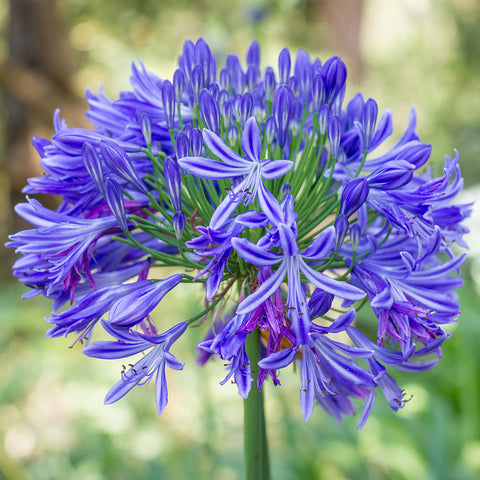Agapanthus Varieties: Choosing the Best for Your Landscape
Agapanthus Varieties: Choosing the Best for Your Landscape
Blog Article
Letting Loose the Secret to Successful Agapanthus Cultivation: Advice for a Flourishing Yard
In the world of horticulture, growing agapanthus effectively requires a strategic strategy that includes numerous elements of plant care. By understanding the nuances of agapanthus farming, one can produce an atmosphere where these plants thrive and flower generously.
Planting Agapanthus: Finest Practices
When planting Agapanthus, correct dirt preparation is vital for making sure successful development and advancement of these gorgeous blossoms. Agapanthus, typically called Lily of the Nile or African lily, thrives in well-draining dirt with a slightly acidic to neutral pH degree - Agapanthus. Before growing, it is important to modify hefty clay dirts with raw material such as compost or peat moss to enhance drainage and supply vital nutrients for the plants
To plant Agapanthus, pick a location that obtains full sunshine to partial shade, as this will promote healthy and balanced growth and plentiful blooming. Dig a hole two times the diameter of the plant's origin sphere and place the Agapanthus at the exact same deepness it was previously expanding. Delicately backfill the hole with dirt, pushing down securely to get rid of any air pockets around the origins.
Water the freshly planted Agapanthus completely and continue to maintain the dirt evenly damp, specifically during the plant's active growing period. Agapanthus. Using a balanced fertilizer once a month can additionally sustain the plant's growth and blooming. By adhering to these best methods for growing Agapanthus, you can create a spectacular display screen of these exciting flowers in your garden
Suitable Dirt Issues for Agapanthus
For ideal growth and growing success of Agapanthus plants, making certain the dirt problems are excellent is critical. Agapanthus likes soil that is abundant in nutrients, so incorporating a balanced plant food during the expanding season can advertise healthy and balanced growth and lively blossoms.

Watering and Fertilizing Tips
To make sure healthy development and dynamic blossoms, appropriate watering and fertilizing methods are vital for effective Agapanthus cultivation. Agapanthus plants benefit from routine watering, especially throughout the expanding period.
When it comes to feeding Agapanthus, a well balanced plant food with equivalent components nitrogen, phosphorus, and potassium can be applied in the springtime to advertise healthy and balanced growth and flowering. Slow-release fertilizers are optimal for offering nutrients slowly over an extended period. Stay clear of over-fertilizing, as this can bring about extreme vegetation development at the expense of blooms.
In addition, integrating organic matter like garden compost into the soil can boost nutrient levels and boost dirt framework, assisting in the general health of the Agapanthus plants. By adhering to these watering and feeding tips, garden enthusiasts can guarantee their Agapanthus plants prosper and produce magnificent screens of flowers.
Trimming and Deadheading Techniques
Correct pruning and deadheading strategies play a vital function in keeping the wellness and looks of look at here now Agapanthus plants, complementing the vital practices of watering and fertilizing for effective growing. Pruning Agapanthus entails removing invested blossom heads, dead or yellowing leaves, and total shaping of the plant to promote far better growth. Deadheading, the procedure of removing faded blossoms, not only boosts the plant's appearance however also motivates more blooming.
When deadheading Agapanthus, it is advisable to clip off the blossom stem at the base making use of sharp, clean shears. This procedure reroutes the plant's energy from seed production back into root and foliage development, promoting a much healthier and extra robust plant. Regular deadheading can prolong the flowering period of Agapanthus and avoid self-seeding, which can result in congestion.
In regards to trimming, Agapanthus normally benefits from a light trim after blossoming to clean the plant and encourage fresh growth. Reducing the spent blossom stems and removing any dead or broken vegetation assists preserve the plant's vitality and general look. Nonetheless, it is vital to prevent reducing into the crown of the plant, as this can compromise its health and wellness.

Protecting Agapanthus From Vermins and Diseases
Carrying out efficient pest and condition monitoring techniques is critical to guarding the health and vigor of Agapanthus plants in cultivation. Agapanthus are generally durable plants, however they can still succumb to different bugs and conditions otherwise correctly cared for. One usual bug that affects Agapanthus is the Agapanthus borer, a caterpillar that passages into the plant, causing damage to the fallen leaves and blossoms. To protect against invasions, regular assessment of the plants is vital. If borers are detected, they can be by hand removed, or insecticidal soap can be made use of as a control procedure.
In addition to insects, Agapanthus are prone to illness such as root rot and fungal leaf spots. By staying watchful and dealing with parasite visit here and illness concerns promptly, gardeners can assist their Agapanthus grow and prosper.

Conclusion
In final thought, effective growing of agapanthus calls for proper growing methods, ideal dirt conditions, appropriate watering and feeding, normal trimming and deadheading, and protection from pests and conditions. By following these ideas and tricks, garden enthusiasts can make sure a prospering garden loaded with attractive agapanthus blooms. Agapanthus. Keep in mind to keep regular care and interest to information to advertise the health and long life of these spectacular plants
When planting Agapanthus, appropriate dirt prep work is essential for guaranteeing effective growth and growth of these beautiful flowers.Water the freshly planted Agapanthus thoroughly and continue to keep the soil uniformly damp, specifically throughout the plant's energetic expanding period.For optimum growth and flowering success of Agapanthus plants, making certain the dirt problems are perfect is crucial. When transplanting or planting Agapanthus, make sure the dirt is well-prepared to provide the needed structure for the plants to develop themselves efficiently. One common pest that affects Agapanthus is read this article the Agapanthus borer, a caterpillar that passages right into the plant, causing damage to the blossoms and fallen leaves.
Report this page